指定された合計に等しいすべての組み合わせをExcelで見つけるにはどうすればよいですか?
特定の合計になるリスト内の数字のすべての可能な組み合わせを見つけることは、予算編成、計画、またはデータ分析の目的で、多くのExcelユーザーが直面する課題です。
この例では、数値のリストがあり、そのリストから合計が480になる組み合わせを特定することが目的です。スクリーンショットは、300+120+60や250+120+60+50などの組み合わせを含む、この合計を得るための5つの可能なグループがあることを示しています。この記事では、指定された値に合計されるリスト内の数値の特定の組み合わせを見つけるためのさまざまな方法を探ります。
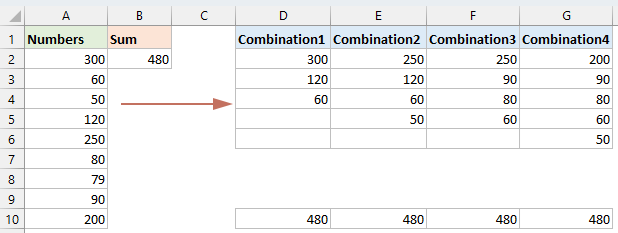
ソルバー関数を使用して指定された合計に等しいセルの組み合わせを見つける
特定の数値に合計されるExcel内のセルの組み合わせを見つけるのは難しく思えるかもしれませんが、ソルバーアドインを使えば簡単です。ここでは、ソルバーを設定し、適切なセルの組み合わせを見つけるための簡単な手順を説明します。複雑に見えるタスクもシンプルで実行可能になります。
ステップ 1: ソルバーアドインを有効にする
- 次に進んでください ファイル > オプションで、 Excelオプション ダイアログボックスで、 アドイン 左ペインから選択し、その後、「 参照 」ボタンをクリックします。スクリーンショットをご覧ください:

- 次に、 アドイン ダイアログが表示されます。「 ソルバーアドイン 」オプションをチェックし、「 OK 」をクリックしてこのアドインを正常にインストールします。

ステップ 2: 数式を入力する
ソルバーアドインを有効にした後、次の数式をセルB11に入力する必要があります:
=SUMPRODUCT(B2:B10,A2:A10)
ステップ 3: ソルバーを設定し結果を得るために実行する
- クリック データ > ソルバー 「 ソルバー パラメーター 」ダイアログボックスに移動し、ダイアログ内で次の操作を行ってください:
- (1.) 「
 」ボタンをクリックして、セル B11 を選択してください。これは「 目的の設定 」セクションにあります;
」ボタンをクリックして、セル B11 を選択してください。これは「 目的の設定 」セクションにあります; - (2.) 次に「To」セクションで「Value Of」を選択し、必要に応じて目標値 480を入力します;
- (3.) 変数セルを変更して セクションで、「
 」ボタンをクリックして、セル範囲 B2:B10 を選択してください。これにより対応する数値がマークされます。
」ボタンをクリックして、セル範囲 B2:B10 を選択してください。これにより対応する数値がマークされます。 - (4.) 次に、「追加」ボタンをクリックします。

- (1.) 「
- 次に、 制約の追加 ダイアログボックスが表示され、「
 」ボタンをクリックして、セル範囲 B2:B10を選択し、「 バイナリ 」をドロップダウンリストから選択します。最後に、「 OK 」ボタンをクリックします。スクリーンショットをご覧ください:
」ボタンをクリックして、セル範囲 B2:B10を選択し、「 バイナリ 」をドロップダウンリストから選択します。最後に、「 OK 」ボタンをクリックします。スクリーンショットをご覧ください: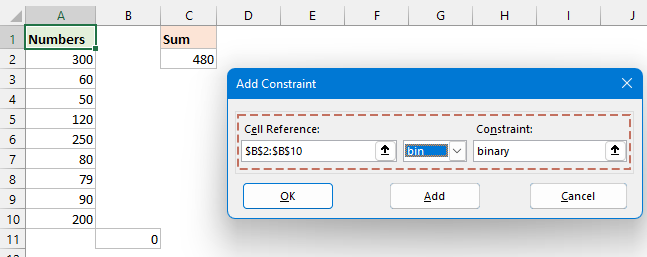
- 「 ソルバー パラメーター 」ダイアログで、「 解決 」ボタンをクリックすると、数分後に「 ソルバー 結果 」ダイアログボックスがポップアップ表示され、指定された合計480に等しいセルの組み合わせが列Bで1としてマークされていることが確認できます。「 ソルバー 結果 」ダイアログで、「 ソルバーの解を保持 」オプションを選択し、「 OK 」をクリックしてダイアログを終了します。スクリーンショットをご覧ください:

指定された合計に等しいすべての数値の組み合わせを取得する
Excelのより深い機能を探求することで、特定の合計に一致するすべての数値の組み合わせを見つけることができ、それは思ったよりも簡単です。このセクションでは、指定された合計に等しいすべての数値の組み合わせを見つけるための2つの方法を紹介します。
ユーザー定義関数を使用して指定された合計に等しいすべての数値の組み合わせを取得する
特定のセットから集計的に指定された値に達するすべての可能な数値の組み合わせを明らかにするために、以下のカスタム関数が効果的なツールとなります。
ステップ 1: VBAモジュールエディターを開き、コードをコピーする
- ExcelでALT + F11キーを押すと、Microsoft Visual Basic for Applicationsウィンドウが開きます。
- クリック 挿入 > モジュールそして、次のコードをモジュールウィンドウに貼り付けます。
VBAコード: 指定された合計に等しいすべての数値の組み合わせを取得するPublic Function MakeupANumber(xNumbers As Range, xCount As Long) 'updateby Extendoffice Dim arrNumbers() As Long Dim arrRes() As String Dim ArrTemp() As Long Dim xIndex As Long Dim rg As Range MakeupANumber = "" If xNumbers.CountLarge = 0 Then Exit Function ReDim arrNumbers(xNumbers.CountLarge - 1) xIndex = 0 For Each rg In xNumbers If IsNumeric(rg.Value) Then arrNumbers(xIndex) = CLng(rg.Value) xIndex = xIndex + 1 End If Next rg If xIndex = 0 Then Exit Function ReDim Preserve arrNumbers(0 To xIndex - 1) ReDim arrRes(0) Call Combinations(arrNumbers, xCount, ArrTemp(), arrRes()) ReDim Preserve arrRes(0 To UBound(arrRes) - 1) MakeupANumber = arrRes End Function Private Sub Combinations(Numbers() As Long, Count As Long, ArrTemp() As Long, ByRef arrRes() As String) Dim currentSum As Long, i As Long, j As Long, k As Long, num As Long, indRes As Long Dim remainingNumbers() As Long, newCombination() As Long currentSum = 0 If (Not Not ArrTemp) <> 0 Then For i = LBound(ArrTemp) To UBound(ArrTemp) currentSum = currentSum + ArrTemp(i) Next i End If If currentSum = Count Then indRes = UBound(arrRes) ReDim Preserve arrRes(0 To indRes + 1) arrRes(indRes) = ArrTemp(0) For i = LBound(ArrTemp) + 1 To UBound(ArrTemp) arrRes(indRes) = arrRes(indRes) & "," & ArrTemp(i) Next i End If If currentSum > Count Then Exit Sub If (Not Not Numbers) = 0 Then Exit Sub For i = 0 To UBound(Numbers) Erase remainingNumbers() num = Numbers(i) For j = i + 1 To UBound(Numbers) If (Not Not remainingNumbers) <> 0 Then ReDim Preserve remainingNumbers(0 To UBound(remainingNumbers) + 1) Else ReDim Preserve remainingNumbers(0 To 0) End If remainingNumbers(UBound(remainingNumbers)) = Numbers(j) Next j Erase newCombination() If (Not Not ArrTemp) <> 0 Then For k = 0 To UBound(ArrTemp) If (Not Not newCombination) <> 0 Then ReDim Preserve newCombination(0 To UBound(newCombination) + 1) Else ReDim Preserve newCombination(0 To 0) End If newCombination(UBound(newCombination)) = ArrTemp(k) Next k End If If (Not Not newCombination) <> 0 Then ReDim Preserve newCombination(0 To UBound(newCombination) + 1) Else ReDim Preserve newCombination(0 To 0) End If newCombination(UBound(newCombination)) = num Combinations remainingNumbers, Count, newCombination, arrRes Next i End Sub
ステップ 2: カスタム数式を入力して結果を得る
コードを貼り付けた後、コードウィンドウを閉じてワークシートに戻ります。結果を出力するために次の数式を空白のセルに入力し、Enterキーを押してすべての組み合わせを取得します。スクリーンショットをご覧ください:
=MakeupANumber(A2:A10,B2)
=TRANSPOSE(MakeupANumber(A2:A10,B2))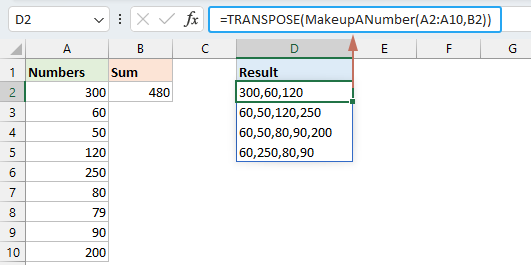
- このカスタム関数は、Excel 365および2021でのみ動作します。
- この方法は正の数値に対してのみ有効であり、小数点以下の値は自動的に最も近い整数に丸められ、負の数値はエラーになります。
強力な機能を使用して指定された合計に等しいすべての数値の組み合わせを取得する
前述の関数の制限を考慮して、迅速かつ包括的な解決策として、Kutools for Excelの「数値補完」機能をお勧めします。この機能はどのバージョンのExcelでも互換性があり、正の数値、小数点以下の値、および負の数値を効果的に処理できます。この機能を使用すると、指定された合計に等しいすべての組み合わせを迅速に取得できます。
- クリック Kutools > コンテンツ > 数値補完スクリーンショットをご覧ください:

- 次に、「 数値補完 」ダイアログボックスで、「
 」ボタンをクリックして、使用したい数値リストを「 データソース」から選択し、合計を「 合計 」テキストボックスに入力します。最後に、「 OK 」ボタンをクリックします。スクリーンショットをご覧ください:
」ボタンをクリックして、使用したい数値リストを「 データソース」から選択し、合計を「 合計 」テキストボックスに入力します。最後に、「 OK 」ボタンをクリックします。スクリーンショットをご覧ください: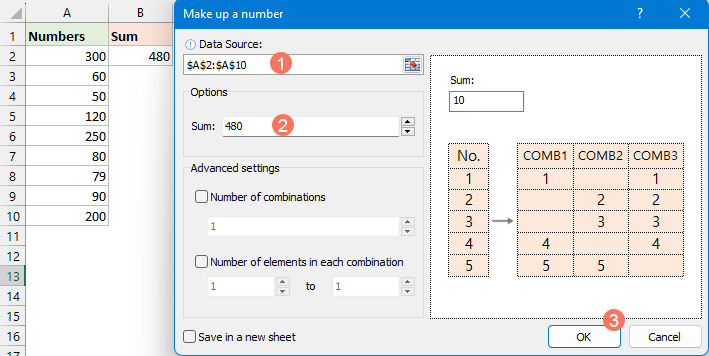
- その後、結果を配置するセルを選択するように促すポップアップボックスが表示されます。次に、「 OK」をクリックします。スクリーンショットをご覧ください:

- そして今、指定された数値に等しいすべての組み合わせが以下のように表示されています:

VBAコードを使用して範囲内の合計を持つすべての数値の組み合わせを取得する
時々、特定の範囲内に合計される数値のすべての可能な組み合わせを特定する必要がある場合があります。例えば、合計が470から480の間になるすべての可能な数値のグループを見つけたい場合などです。
特定の範囲内の合計に加算されるすべての可能な数値の組み合わせを見つけることは、Excelにおいて興味深く非常に実用的な課題です。このセクションでは、このタスクを解決するためのVBAコードを紹介します。
ステップ 1: VBAモジュールエディターを開き、コードをコピーする
- ExcelでALT + F11キーを押すと、Microsoft Visual Basic for Applicationsウィンドウが開きます。
- クリック 挿入 > モジュールそして、次のコードをモジュールウィンドウに貼り付けます。
VBAコード: 特定の範囲に合計されるすべての数値の組み合わせを取得するSub Getall_combinations() 'Updateby Extendoffice Dim xNumbers As Variant Dim Output As Collection Dim rngSelection As Range Dim OutputCell As Range Dim LowLimit As Long, HiLimit As Long Dim i As Long, j As Long Dim TotalCombinations As Long Dim CombTotal As Double Set Output = New Collection On Error Resume Next Set rngSelection = Application.InputBox("Select the range of numbers:", "Kutools for Excel", Type:=8) If rngSelection Is Nothing Then MsgBox "No range selected. Exiting macro.", vbInformation, "Kutools for Excel" Exit Sub End If On Error GoTo 0 xNumbers = rngSelection.Value LowLimit = Application.InputBox("Select or enter the low limit number:", "Kutools for Excel", Type:=1) HiLimit = Application.InputBox("Select or enter the high limit number:", "Kutools for Excel", Type:=1) On Error Resume Next Set OutputCell = Application.InputBox("Select the first cell for output:", "Kutools for Excel", Type:=8) If OutputCell Is Nothing Then MsgBox "No output cell selected. Exiting macro.", vbInformation, "Kutools for Excel" Exit Sub End If On Error GoTo 0 TotalCombinations = 2 ^ (UBound(xNumbers, 1) * UBound(xNumbers, 2)) For i = 1 To TotalCombinations - 1 Dim tempArr() As Double ReDim tempArr(1 To UBound(xNumbers, 1) * UBound(xNumbers, 2)) CombTotal = 0 Dim k As Long: k = 0 For j = 1 To UBound(xNumbers, 1) If i And (2 ^ (j - 1)) Then k = k + 1 tempArr(k) = xNumbers(j, 1) CombTotal = CombTotal + xNumbers(j, 1) End If Next j If CombTotal >= LowLimit And CombTotal <= HiLimit Then ReDim Preserve tempArr(1 To k) Output.Add tempArr End If Next i Dim rowOffset As Long rowOffset = 0 Dim item As Variant For Each item In Output For j = 1 To UBound(item) OutputCell.Offset(rowOffset, j - 1).Value = item(j) Next j rowOffset = rowOffset + 1 Next item End Sub
ステップ 2: コードを実行する
- コードを貼り付けた後、 F5 キーを押してこのコードを実行します。最初に表示されるダイアログで、使用したい数値の範囲を選択し、「 OK」をクリックします。スクリーンショットをご覧ください:

- 2番目のプロンプトボックスで、下限の数値を選択または入力し、「 OK」をクリックします。スクリーンショットをご覧ください:

- 3番目のプロンプトボックスで、上限の数値を選択または入力し、「 OK」をクリックします。スクリーンショットをご覧ください:
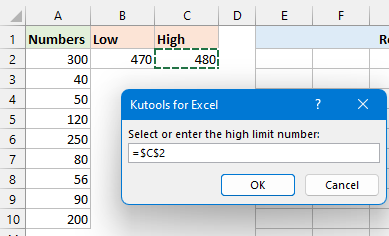
- 最後のプロンプトボックスで、結果が出力される開始セルを選択します。次に「 OK」をクリックします。スクリーンショットをご覧ください:

結果
これで、条件を満たす各組み合わせが、選択した出力セルから始まる連続した行にリストされます。
Excelでは、特定の合計に加算される数値のグループを見つけるためのいくつかの方法があります。各方法は異なる仕組みで動作するため、Excelの習熟度やプロジェクトの要件に基づいて選択できます。さらに多くのExcelのヒントやコツについて知りたい場合は、当サイトには数千のチュートリアルが掲載されています。ご閲覧いただきありがとうございます。今後とも役立つ情報を提供できるよう努めてまいります!
関連記事:
- すべての可能な組み合わせをリストまたは生成する
- 例えば、次の2つの列のデータがあり、左側のスクリーンショットに示すように、これらの2つのリストの値に基づいてすべての可能な組み合わせのリストを生成したいとします。値が少ない場合は、すべての組み合わせを1つずつリストすることができますが、複数の列に複数の値があり、それらの可能な組み合わせをリストする必要がある場合、いくつかの簡単なトリックがこの問題を解決するのに役立つかもしれません。
- 単一列からのすべての可能な組み合わせをリストする
- 次のスクリーンショットに示すように、単一列のデータからすべての可能な組み合わせを返したい場合、Excelでこのタスクを処理するための簡単な方法はありますか?
- 3つ以上の列のすべての組み合わせを生成する
- 例えば、3つの列のデータがあり、これらの3つの列のデータに基づいてすべての組み合わせを生成またはリストしたいとします。次のスクリーンショットに示すように、Excelでこのタスクを解決する良い方法はありますか?
- すべての可能な4桁の組み合わせのリストを生成する
- 場合によっては、0から9までの数字のすべての可能な4桁の組み合わせのリストを生成する必要があるかもしれません。つまり、0000、0001、0002…9999のリストを生成することを意味します。Excelでこのリスト作業を迅速に解決するためのいくつかのトリックをご紹介します。
最高のオフィス業務効率化ツール
| 🤖 | Kutools AI Aide:データ分析を革新します。主な機能:Intelligent Execution|コード生成|カスタム数式の作成|データの分析とグラフの生成|Kutools Functionsの呼び出し…… |
| 人気の機能:重複の検索・ハイライト・重複をマーキング|空白行を削除|データを失わずに列またはセルを統合|丸める…… | |
| スーパーLOOKUP:複数条件でのVLookup|複数値でのVLookup|複数シートの検索|ファジーマッチ…… | |
| 高度なドロップダウンリスト:ドロップダウンリストを素早く作成|連動ドロップダウンリスト|複数選択ドロップダウンリスト…… | |
| 列マネージャー:指定した数の列を追加 |列の移動 |非表示列の表示/非表示の切替| 範囲&列の比較…… | |
| 注目の機能:グリッドフォーカス|デザインビュー|強化された数式バー|ワークブック&ワークシートの管理|オートテキスト ライブラリ|日付ピッカー|データの統合 |セルの暗号化/復号化|リストで電子メールを送信|スーパーフィルター|特殊フィルタ(太字/斜体/取り消し線などをフィルター)…… | |
| トップ15ツールセット:12 種類のテキストツール(テキストの追加、特定の文字を削除など)|50種類以上のグラフ(ガントチャートなど)|40種類以上の便利な数式(誕生日に基づいて年齢を計算するなど)|19 種類の挿入ツール(QRコードの挿入、パスから画像の挿入など)|12 種類の変換ツール(単語に変換する、通貨変換など)|7種の統合&分割ツール(高度な行のマージ、セルの分割など)|… その他多数 |
Kutools for ExcelでExcelスキルを強化し、これまでにない効率を体感しましょう。 Kutools for Excelは300以上の高度な機能で生産性向上と保存時間を実現します。最も必要な機能はこちらをクリック...
Office TabでOfficeにタブインターフェースを追加し、作業をもっと簡単に
- Word、Excel、PowerPointでタブによる編集・閲覧を実現。
- 新しいウィンドウを開かず、同じウィンドウの新しいタブで複数のドキュメントを開いたり作成できます。
- 生産性が50%向上し、毎日のマウスクリック数を何百回も削減!
全てのKutoolsアドインを一つのインストーラーで
Kutools for Officeスイートは、Excel、Word、Outlook、PowerPoint用アドインとOffice Tab Proをまとめて提供。Officeアプリを横断して働くチームに最適です。
- オールインワンスイート — Excel、Word、Outlook、PowerPoint用アドインとOffice Tab Proが含まれます
- 1つのインストーラー・1つのライセンス —— 数分でセットアップ完了(MSI対応)
- 一括管理でより効率的 —— Officeアプリ間で快適な生産性を発揮
- 30日間フル機能お試し —— 登録やクレジットカード不要
- コストパフォーマンス最適 —— 個別購入よりお得












